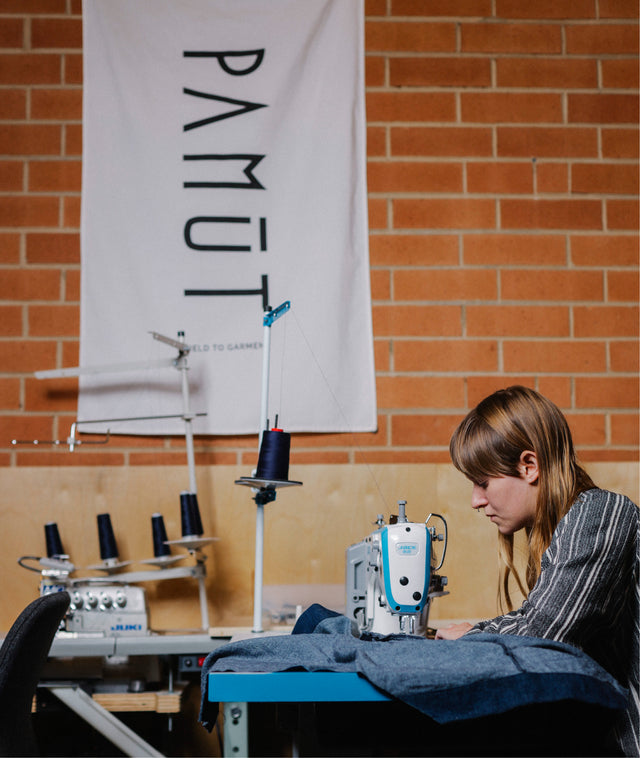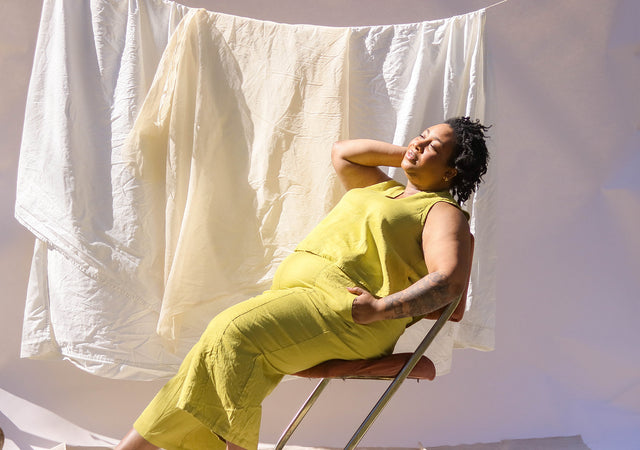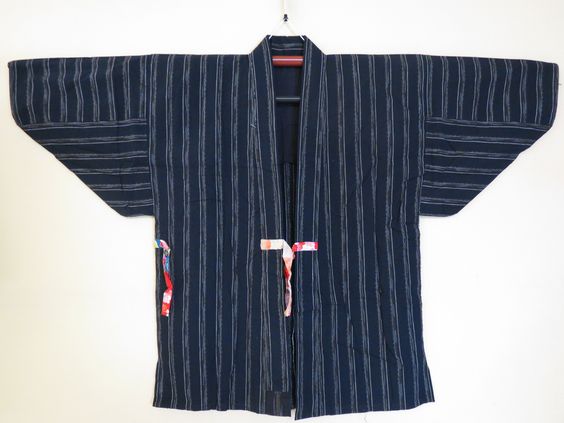*Before reading this blog post, I highly recommend that you read this article written by Emi Ito, a Japanese-American who speaks about cultural appropriation of traditional Japanese garments. I consulted with Emi while writing this piece, and feel that it is important to first know her opinion before reading mine. The image of the Haori in this article is one of my original inspiration photos for FW20.
Recently, a customer posed a question to me: Why have I named a Pamut garment, the Uma Haori, after a traditional Japanese garment? Some people consider this to be cultural appropriation, and could be offended by me, a white person, using the name to label a garment that I sell. The customer suggested that maybe I should change the name of this garment, perhaps to the Uma Jacket. I thought about this for a while. In fact, I hardly slept at all that night. Would simply changing the name of the garment be enough, or would that avoid or even potentially worsen the issue by covering up the garment’s true origins? Delving into the issue further, I wondered if it was unethical to even be inspired by the idea of a traditional Japanese garment, seeing as I am white and not Japanese. The concept of “being inspired” by traditional cultural items is by no means new, but in the year 2021, does it still have a place? Was my act of creating and naming this garment an act of cultural appropriation?
To properly understand this issue, we must first discuss a human’s basic needs. Rudimentarily, these are food, shelter, and clothing. These three categories are considered essential for human existence. By law (just about everywhere), they cannot be trademarked. This allows anyone on the planet to legally make/fabricate and sell an adobe house or tom yum soup or a caftan. It also allows for advancements in technology and design in these categories. You can’t patent the idea of a button, a fireplace, or bread because this would be detrimental to societal progress. This “human needs” rule is why Kim Kardashian would never be able to actually trademark the word kimono. On the other hand, it’s also why Forever 21 can rip off an indie brand’s jacket design and not get sued.
As an artist and designer, I find myself often inspired by non-white culture and garments. It’s hard not to in a world that is so blended! While trying to come up with a perfect second layer garment to add to the Pamut line, I came across the concept of the Haori. The Haori, a traditional Japanese layering piece, is typically made of a midweight woven fabric and, though it has a collar, does not cross over at the front and is meant to be worn partially open. I found this to be an ingenious concept, and realized that there is no real modern equivalent in American culture. We have the jacket, but jackets include a closure and are typically more fitted. We also have the cardigan, but this is a knit item and poses a problem to me as a designer because it would probably have to be labeled as dry-clean only. I took the concept of the Haori, changed some elements, and added it to the Pamut line as the Uma Haori. Is what I did cultural appropriation?
I believe that cultural appropriation involves exploitation. Exploitation is profiting off of others in order to benefit from their work, and it often involves deception. Where you draw the line here can be a little fuzzy, so let’s go back to the Haori and my business for some more details. Did I exploit Japanese-Americans by selling a Haori? My assistant and I make all of our garments, including the Uma Haori, in-house from ethically sourced fabric. I don’t pretend to be Japanese, and I’m transparent about how the garment is made. I sell the Uma Haori online, and there are many other sustainable/slow fashion brands that sell a similar item (whether they choose to call it a Haori or not). But there is plenty of business to go around, and no need for me to compete directly with these other slow fashion brands. If we look at my business model, it’s clear that I am not actively exploiting anyone. Note that if I became a Jeff Bezos-style billionaire, started buying my fabric from an impoverished province in Japan, and employed underpaid Japanese Americans to sew my products, I would DEFINITELY be guilty of exploitation and cultural appropriation).
Does the problem lie in the name of the product? Perhaps it would be better if I renamed my garment, and instead called it a jacket. Well, a rose by any other name would smell as sweet. In other words, the Pamut Haori is still, in essence, a Haori. More importantly, by changing the name of the said garment, I am no longer giving credit to the origin of the item. I did not invent this garment, and I would argue that I shouldn’t be deceptive by avoiding or hiding the true inspiration behind it.
Inspiration is a key word here. I was inspired by a traditional Haori to create my own interpretation, adding elements like a slimmer sleeve and denim fabric in order to differentiate my design. A purist, a lover of traditional Japanese culture, may be offended or upset by this fusion of style. (I am also occasionally offended by fusion fashion, Gaucho Pants in 2006, for instance). However, one must accept that some fusion ideas are downright fundamental to progress. The caftan is one example, commonly worn for centuries in warm climes such as Africa and the Iranian plateau. The caftan was popularized in the West in the 1950’s and was a key garment in liberating women from hourglass silhouettes. But the best example of a garment invented and worn by a marginalized culture and then adopted by a Western one is… PANTS. Pants were invented by the Chinese and eventually worn by Eurasian Nomads, who appreciated the pant as a horse-riding garment. These traveling warriors came into contact with the Greeks and later, the Romans. Both of these cultures initially viewed pants as crude and almost comical. Pants were only worn by enslaved people and by people that they considered “uncivilized”. But, eventually the Romans changed their view on the pant, adopting the idea and adding their own spin, as did many other cultures in the centuries to come. If we say that cultural fusion is wrong, then we lose the ability to build off of old ideas. We lose our ability to be inspired, to interpret, to translate, and to improve on a concept. A world without fusion would be a drab, divided (and pantsless) world indeed.
By logic and for the sake of creativity, it follows that we should allow designers, chefs, architects, and makers to take inspiration from wherever they find it. But regardless of my personal beliefs about creative freedom, the fact is that I may have caused emotional harm to someone; someone from a culture that has been marginalized and deeply wounded by humanity’s past actions. I may have hurt people. The whole point of owning an ethical clothing company is to prevent hurt, and to create a positive and inclusive space for everyone. I messed up! If I had known that some people would be upset by my interpretation of this garment, I may have rethought the design. But here’s the problem. If, going forward, I limited my designs to only European-inspired garments, would I be contributing to cultural division and slowing the exchange of ideas? On a more practical note, if I cut a great-selling item that I’ve put a lot of development money into from the line, I risk, at best, credit card debt and hours of lost work; at worst, having to cut my employee’s hours. In a wider sense, does erasing cultural fusion fix the problem, or only create a deeper wound?
Perhaps there is a solution that works for everyone. Maybe it won’t be perfect, but I’m going to try. I may have upset and hurt Japanese-Americans by taking inspiration from a cherished cultural item. First, it was very important to me that I share this story with you, my customers and followers. Second, I want to apologize to any person that I hurt by using a Haori as inspiration. Third, in order to avoid further distress for Japanese-Americans, I am choosing to change the name of the said garment to the Uma Layering Jacket, putting in the product description that it was inspired by a traditional Japanese Haori. Fourth, I promise to always seek inspiration with awareness, devoting time and care to honoring the heritage of the garment or technique. I’ll be spending time this week working on a way to give back to the Japanese-American community and I will keep you posted on what comes from this.
I do maintain that cultural fusion is vital to creativity and progress. I also believe that the exchange of ideas and cultures brings us all closer together, while cultural erasure can hold us apart. Here is what I will take away from this: Be kind, be aware, and ask for forgiveness. Give credit where credit is due, without creating further trauma. Give reparations if there is a potential for hurt. The past cannot be changed, but together we can make the future a better place.
A big thanks to Emi Ito for her input, as well as my good friend River Takada, who also shared her opinions with me regarding this issue. You can find River's work here.
Mentioned in this article
More stories

A Day In Our New Studio



